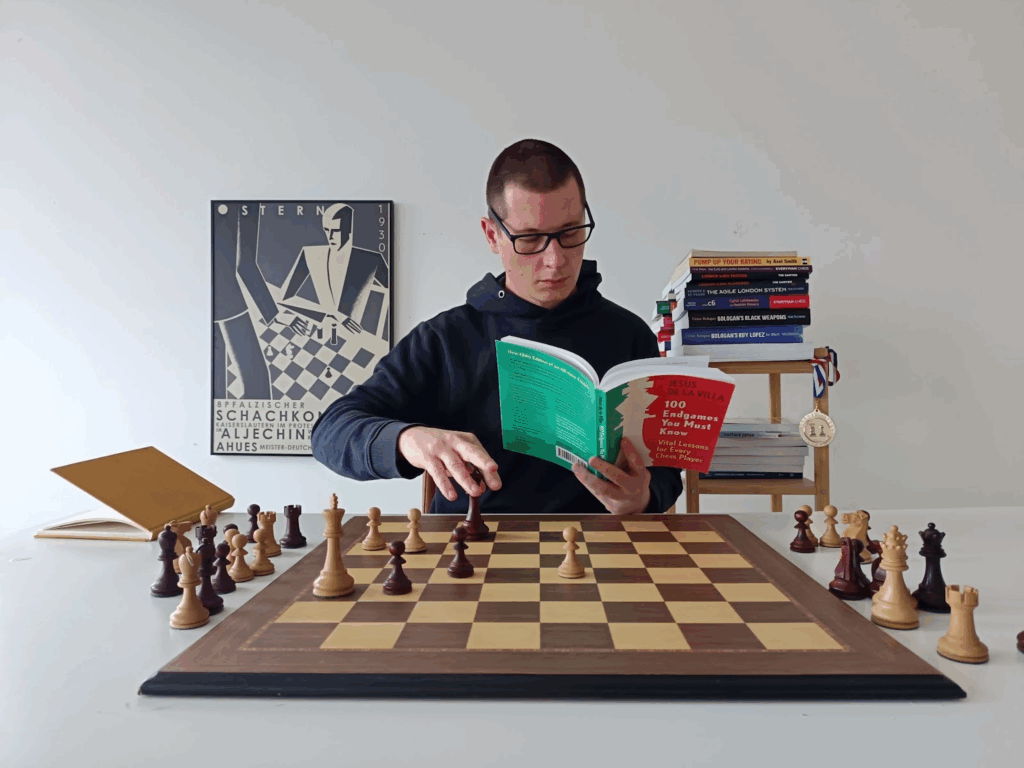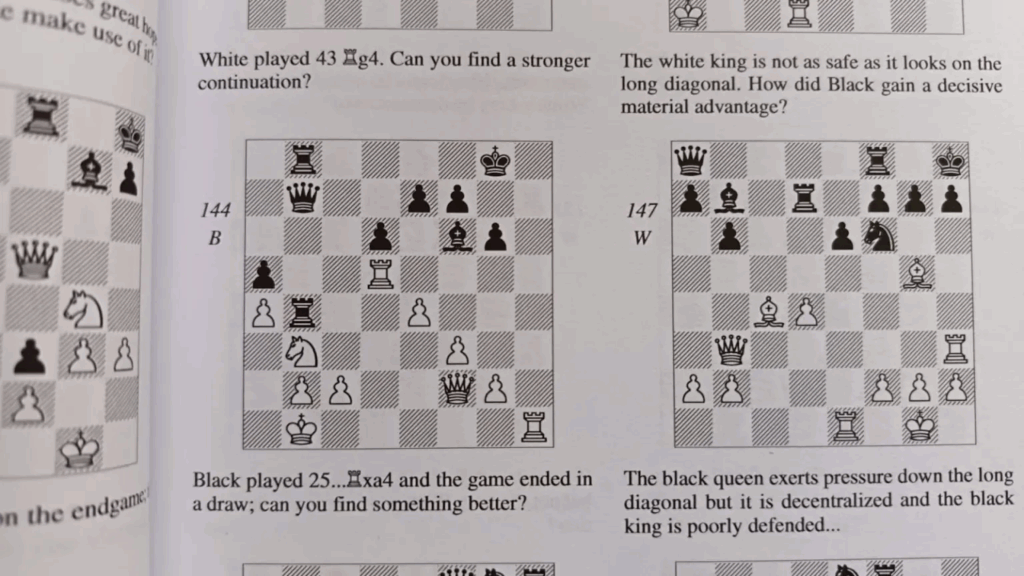Introduction
When it comes to openings, I think beginners should not focus on them. I think you should choose an opening repertoire and stick with it. These books should be used with an actual chess board on the side. Try to set up every position, try to solve every position without moving the pieces, and try to go as deep as you can and write your analysis down. Our goal as beginners is to recreate tournament conditions while we train.
1. 100 Endgames You Must Know, Jesus de la Villa
100 Endgames You Must Know has become the most popular endgame book of all time alongside Dvoretsky’s Endgame Manual. It covers every important theoretical endgame in a simple, easily understandable way, with clear explanations, covering key ideas, patterns and concepts, making it a truly great resource for players of all levels.

Each chapter is accompanied by clear instructions of what to do, what to avoid, how to approach a specific type of endgame, and common problems one might encounter while playing them. What’s unique about it is that it only covers endgames that happen frequently in tournament play.

The best thing about 100 Endgames You Must Know are the explanations of ideas and concepts. Each chapter is accompanied by clear instructions of what to do, what to avoid, how to approach a specific type of endgame, and common problems one might encounter while playing them.
Read 100 Endgames You Must Know
2. 1001 Chess Endgame Exercises for Beginners, Thomas Willemze
1001 Chess Endgame Exercises for Beginners covers a relatively narrow section of the game but it does so in an extraordinarily useful manner. Willemze has created an introduction on how to win and how to not lose with reduced material.

I think that has never been done before on a level that beginners can easily follow. Rather than studying theoretical endgames which may occur once in 50 games, practicing what WIllemze teaches will be applicable in every game you play, even if it hasn’t reached an endgame yet.
Read 1001 Chess Endgame Exercises for Beginners
3. Endgame Strategy, Mikhail Shereshevsky
Instead of going over theoretical endgames and endless variations, the Endgame Strategy focuses on essential endgame principles, patterns, and ideas one must master in order to navigate complex endgames, regardless of the pieces involved. I can’t think of a book that has helped me win more points and half-points in over the board classical games.

Endgame Strategy is divided into 15 chapters, each focusing on an essential endgame principle applicable in almost any complex endgame, such as “Centralizing the King”, “The principle of two Weaknesses”, “Between assessment and calculation” (which I found particularly useful), and “Do not hurry”, a rule every Russian chess player must have heard their coach say countless times.
4. Chess Pattern Recognition for Beginners, Arthur van de Oudeweetering
Chess Pattern Recognition for Beginners is a great book for all novice players who wish to grasp the basics of strategy, pawn structures, positional concepts, and attacking and defensive tactical themes. It’s “The Fundamental Guide to Spotting Key Moves in the Middlegame”.

It teaches basic pattern recognition and concepts one must understand before moving on to more subtle topics. It is primarily tailored for players that lack basic positional and strategic knowledge. Those who have never been introduced to ideas such as controlling open files, or prying open diagonals for your bishops, but stronger players will benefit from it too. I have!
Read Chess Pattern Recognition for Beginners
5. How to Study Chess on Your Own, Davorin Kuljasevic
How to Study Chess on Your Own is a practical guide on perfecting your chess study. Its purpose is to, as Davorin puts it: “Encourage readers to study with proper structure, and help readers become independent in their study.”

I think the book is intended for adult improvers, although Kuljašević at no point says so himself. Those of us who are struggling, those who have hit a plateau, and those of us who don’t have 10 hours a day they can devote to chess. It has become one of my favorite chess books. The series is intended, as he puts it, for everyone from casual club players to chess professionals. The other three volumes in the series are workbooks, each for a separate level range (1500-1800, 1800-2100, and 2100+).
6. Perpetual Chess Improvement, Ben Johnson
Ben made it possible for improving players like myself to get a glimpse of how others approach the greatest question in chess: How do I improve? His Perpetual Chess Podcast provided me, and many others, with a way to get the much needed answer to that, and to many other questions. After years of interviewing the most influential people in the chess world, Ben has assembled a book that captures the essence of those hundreds of conversations.

Perpetual Chess Improvement is the “best off” of the podcast. It’s actually more than that. It’s a collection of answers to chess’ most frequently asked questions. The FAQ section of chess.
Read Perpetual Chess Improvement
7. The Giant Chess Puzzle Book, Zenon Franco
The Giant Chess Puzzle Book is a great resource for beginners and advanced players alike. It begins by covering every important tactical theme, concept and pattern one needs to understand in order to solve puzzles successfully and efficiently. It continues with a set of elementary, introductory problems, many of which are accompanied by written hints, something many tactics books lack. From here, things get more difficult.

The rest of the positions are harder, in increasing difficulty, finishing with problems on Grandmaster level, but still accompanied by hints to start with, making each chapter easy to approach, and each set of problems more understandable for inexperienced players.


